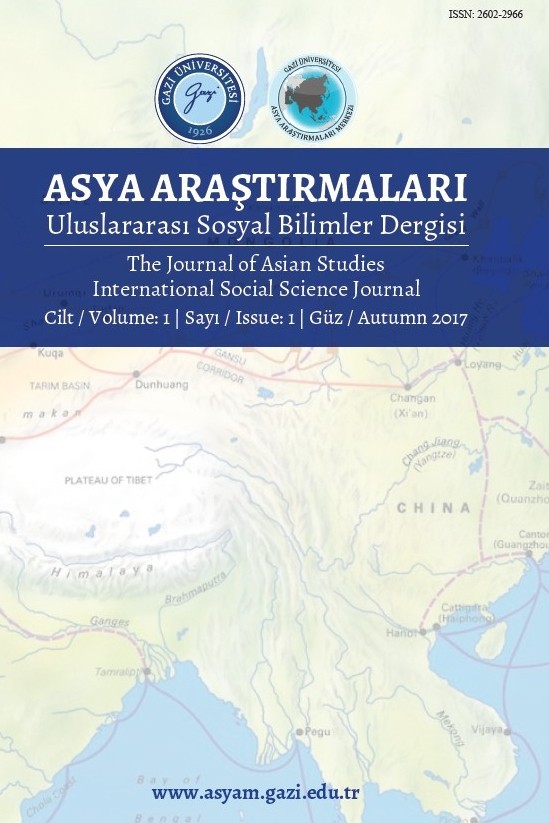(RE)PRODUCTION OF HINDUTVA-DRIVEN POPULISM IN INDIA: AN ANALYSIS OF BHARATIYA JANATA PARTY’S POLITICAL MESSAGING IN TWITTERSPHERE
Bharatiya Janata Partisi, Narendra Modi, Hindutva, Sağ Popülizm, Siyasal İletişim, Hint Milliyetçiliği
(RE)PRODUCTION OF HINDUTVA-DRIVEN POPULISM IN INDIA: AN ANALYSIS OF BHARATIYA JANATA PARTY’S POLITICAL MESSAGING IN TWITTERSPHERE
Bharatiya Janata Party, Narendra Modi, Hindutva, Right-wing Populism, Political Communication, Indian Nationalism,
___
- Andersen, W., & Damle, S. (1987). The Brotherhood in Saffron. The Rashtriya Swayamsevak Sangh and Hindu Revivalism. New Delhi: Vistaar Publications.
- Baumgart-Ochse, C. (2009). Democratization in Israel, politicized religion and the failure of the Oslo peace process. Democratization, 16(6), 1115-1142.
- Bhatt, C. (2001). Hindu Nationalism: Origins, Ideologies, and Modern Myths. New York: Berg.
- Bhattacharyya, N. N. (1982). History of the Tantric Religion. New Delhi: Manohar.
- Bourdieu, P. (1991). Language and Symbolic Power. Cambridge: Harvard University Press.
- Canovan, M. (1981). Populism. New York: Harcourt Brace Jovanovich.
- Canovan, M. (1999). Trust the People! Populism and the Two Faces of Democracy. Political Studies, 47(1), 2–16.
- Canovan, M. (2002). Taking Politics to the People: Populism as the Ideology of Democracy. In Y. Mény, & S. Y., Democracies and the Populist Challenge (pp. 25-44). London: Palgrave Macmillan.
- Castells, M. (2007). Communication, power and counter-power in the network society. International Journal of Communication, 1, 238–266.
- Chaudhuri, N. C. (1951). The Autobiography of an Unknown Indian. New York: Macmillan.
- Chitkara, M. (2004). Hindutva Parivar. New Delhi: APH Publishing Corporation.
- Di Tella, T. (1965). Populism and reform in Latin America. In C. Veliz, Obstacles to change in Latin America. Oxford: Oxford University Press.
- Di Tella, T. (1997). Populism in the twenty-first century. Government and Opposition, 32, 187-200.
- Diwakar, R. (2015). The 16th general election in India, April–May 2014. Electoral Studies, 37, 120-125.
- Fairclough, N. (1992). Discourse and social change. Oxford: Polity Press.
- Fairclough, N. (2013). Critical discourse analysis and critical policy studies. Critical Policy Studies(2), 177-197.
- Filc, D. (2010). The Political Right in Israel: Different Faces of Jewish Populism. London: Routledge.
- Frykenberg, R. (2008). Hindutva as a Political Religion: An Historical Perspective. . In G. R., M. R., & T. J., The Sacred in Twentieth-Century Politics (pp. 178-220). London: Palgrave Macmillan.
- Golwalkar, M. (1939). We or Our Nationhood Defined. Retrieved April 2020, from https://sanjeev.sabhlokcity.com/Misc/We-or-Our-Nationhood-Defined-Shri-M-S-Golwalkar.pdf
- Golwalkar, M. S. (1966). Bunch of Thoughts . Bangalore: Rashtrotthana Sahitya.
- Goyal, D. R. (1979). Rashtriya Swayamsevak Sangh. Delhi: Radha Krishna Prakashan.
- Ionescu, E., & Gellner, G. (1969). Populism: its meanings and national characteristics. London: Weidenfeld & Nicolson.
- Jaffrelot, C. (1996). The Hindu Nationalist Movement and Indian Politics: 1925 to the 1990s : Strategies of Identity-building, Implantation and Mobilisation. London: C. Hurst & Co. Publishers.
- Jaffrelot, C. (2007). The Sangh Parivar and the Hindu diaspora in the West. What kind of ‘long-distance nationalism’? International Political Sociology, 3.
- Jaffrelot, C. (2013). Refining the moderation thesis. Two religious parties and Indian democracy: the Jana Sangh and the BJP between Hindutva radicalism and coalition politics. Democratization, 20(5), 876-894.
- Kanungo, P. (2002). RSS’s Tryst with Politics: From Hedgewar to Sudarshan. New Delhi: Manohar.
- Kanungo, P. (2006). Myth of the Monolith: The RSS Wrestles to Discipline its Political Progeny. Social Scientist, 34(11/12), 51–69.
- Kaul, N. (2017). Rise of the Political Right in India: Hindutva‐Development Mix, Modi Myth, and Dualities. Journal of Labor and Society, 20(4), 523-548.
- Kazin, M. (1995). The populist persuasion: An American History. New York: Cornell University Press.
- Kitschelt, H., & McGann, A. (1995). The Radical Right in Western Europe: A Comparative Analysis. University of Michigan Press.
- Kumar, G. S., & Muralidhar, B. V. (1997). Achieving Communal harmony and National Integration: A Dream for Every Indian. . New Delhi: MD Publication PVT LTD.
- Lahiry, S. (2005). Jana Sangh and Bharatiya Janata Party: A Comparative Assessment of Their Philosophy and Strategy and Their Proximity with the Other Members of the Sangh Parivar. The Indian Journal of Political Science, 66(4), 833.
- Mudde, C. (2016). Europe's Populist Surge: A Long Time in the Making. Foreign Affairs, 95(6), 25–30.
- Przeworski, A. (1991). Democracy and the Market: Political and Economic Reforms in Eastern Europe and Latin America. Cambridge: Cambridge University Press.
- Qureshi, M. N. (1989). Whither History? The State of the Discipline in Pakistan. In S. H. Hashmi, In The State of Social Sciences in Pakistan. Islamabad,: Quaid-i-Azam University.
- Savarkar, V. (1924). Essentials of Hindutva. Retrieved April 2020, from http://www.savarkar.org/en/hindutva-hindu-nationalism/essentials-hindutva
- Savarkar, V. (1989). Hindutva – Who is a Hindu? New Delhi: Bhartiya Sahitya Sadan.
- Sil, N. (2002). Bande Mataram: Bankimchandra Chattopadhyay's nationalist thought revisited. South Asia: Journal of South Asian Studies, 25(1), 121-142.
- Smith, D. (1966). South Asian Politics and Religion. Princeton: Princeton University Press.
- Taggart, P. (2002). Populism and the Pathology of Representative Politics. In M. Y., & S. Y., Democracies and the Populist Challenge (pp. 62-80). London: Palgrave Macmillan.
- Taggart, P. A. (2000). Populism. Buckingham: Open University Press.
- Tessler, M. (1990). Religious Resurgence and Politics in the Contemporary World. New York: State University of New York Press.
- Thompson, J. B. (1995). The media and modernity: a social theory of the media. Cambridge: Polity.
- Udayakumar, S. (2005). Presenting the past: Anxious history and ancient future in Hindutva India. Westport: Greenwood Publishing Group.
- Westlind, D. (1996). The politics of popular identity: Understanding recent populist movements in Sweden and the United States. Lund University Press.
- Zain, A. (2019). Rise of Modi's Tech-Populism. Moment: Journal of Cultural Studies, 6(1), 199-208.
- ISSN: 2667-6419
- Yayın Aralığı: Yılda 2 Sayı
- Başlangıç: 2017
- Yayıncı: Ankara Hacı Bayram Veli Üniversitesi
ASYA ÇALIŞMALARI UYGULAMA VE ARAŞTIRMA MERKEZİ’NİN 2021 YILI FAALİYETLERİ
KİTAP TANITIMI: “EMPERYALİST ÇAĞDA MODERNLEŞME-TÜRK MODERNLEŞMESİ VE İRAN (1800-1941)” ADLI ESER
WESTLESSNESS UNDER CHINESE NATIONALISM: AN EPISTEMOLOGICAL ATTEMPT OR AN ONTOLOGICAL CASE?
KUŞAK VE YOL GİRİŞİMİ (KYG) PROJELERİNİN İNCELENMESİ; TÜRKİYE İÇİN ÖNERİLER
TARİHTEN GÜNÜMÜZE İRAN’DAKİ TÜRKLER VE TÜRK-İRAN İLİŞKİLERİ
ABD'NİN AFGANİSTAN'DAN ÇEKİLMESİ İLE TALİBAN'IN YENİDEN İKTİDARA GELMESİ
